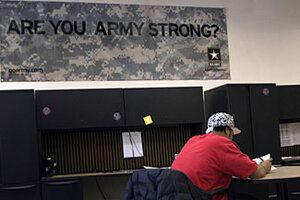To boost recruits, US Army relaxes weight rules
The waiver program allows overweight enlistees to get in shape after they sign up.

Enlisting: A potential recruit fills out paperwork at an Army recruiting station in Brooklyn, New York. The recession has upped recruitment, but obesity remains a barrier for many.
Joanne Ciccarello/Staff/File
Washington
The waistlines of America's youth are expanding, shrinking the pool of those eligible to join the US military. But an Army program is giving overweight enlistees a second chance – and helping the military with its own expansion.
The recently-introduced waiver program allows enlistees who don't qualify for the military because of their weight a chance to shape up after joining. So far, the program has helped the Army make its recruiting goals in what remains a tight recruiting market.
If the economic recession worsens, it could help the military's recruiting efforts as people seek stable employment. That could reduce the need for waiver programs. However, nutritionists don't see the trend of overweight Americans disappearing any time soon, ensuring the continuance of such programs in recruiting an all-volunteer force.
"We support any service who comes up with a scientifically defensible way of expanding the market [of recruits]," says Curtis Gilroy, director of accessions policy for the Pentagon.
Such waivers had been studied for years but the program wasn't implemented until fiscal 2007, when it admitted about 1,500 individuals through the program (just a small slice of about 80,000 recruits). Recruits must pass a special battery of tests, including a "step test," and do a number of push-ups to demonstrate their physical abilities. If they pass and are enlisted, they have a year to comply with the Army's physical requirements, measured by "body mass index," a formula that estimates body fat based on weight and height.
Recruiting struggle
The Army's weight waiver program rests largely on a distinction between individuals who are overweight or obese and those who are physically fit but whose "body mass index," or BMI, doesn't meet Army standards.
"The point is to get the football-player kinda kids. It's not to get the couch-potato kids," says Beth Asch, a senior economist at the Rand Corporation who studies military recruiting.
The Army program is a "sensible move," says Ms. Asch, but to remain effective it must have oversight.
"There can be a temptation, not necessarily at the commanding level but at the ground level with the recruiter, who would want to slip in a kid who is overweight and has no business being in the Army," she says. "There needs to be monitoring."
So far, the percentage of those in the program who don't get into shape – and are then discharged from the Army – is low among both men and women. It roughly mirrors the attrition rates of those who don't take the special test, according to data provided by Douglas Smith of Army Recruiting Command.
The Army has struggled the most with recruiting. Although it has met its active-duty goals in recent years, it has had to issue other waivers and let in more high school dropouts in order to do so.
At the same time, the military is expanding through next year. The Marine Corps, which is not using the weight waiver, is growing to 202,000 and the Army will reach its "end-strength" goal of 547,000 this year.
Many experts would like to see the military grow even larger to meet demands.
The obesity challenge
Excess weight is the chief reason many individuals can't enlist.
It's no secret that today's youths gobble up french fries and suck down Big Gulps. At the same time, fewer are getting exercise. The percentage of young adults considered obese – with a BMI greater than 30 – has grown sharply in recently years.
Ten years ago, there were a handful of states across the country where about 25 percent of the population ages 18 to 34 were considered obese. Today, there are 26 such states.
"We know that is even going to increase because the [Centers for Disease Control] says the numbers are going to go up," says the Pentagon's Mr. Gilroy.
It's a big change from 50 years ago, when there was widespread fear that soldiers were "undernourished," says Linda Van Horn, professor of preventive medicine at Northwestern University's Feinberg School of Medicine.
Today, Americans live in an age of super-sized proportions. According to the National Institutes of Health, the average-sized bagel 20 years ago was three inches across and had 140 calories. Today's bagels average twice the size and have about 350 calories.
And more Americans are eating fast food, which is cheap, plentiful – and generally unhealthy. "There is no question that America is eating out," says Ms. Van Horn.
